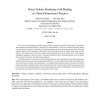Free Online Productivity Tools
i2Speak
i2Symbol
i2OCR
iTex2Img
iWeb2Print
iWeb2Shot
i2Type
iPdf2Split
iPdf2Merge
i2Bopomofo
i2Arabic
i2Style
i2Image
i2PDF
iLatex2Rtf
Sci2ools
VVS
1996
IEEE
1996
IEEE
Direct Volume Rendering with Shading via Three-Dimensional Textures
A new and easy-to-implement method for direct volume rendering that uses 3D texture maps for acceleration, and incorporates directional lighting, is described. The implementation, called Voltx, produces high-quality images at nearly interactive speeds on workstations with hardware support for three-dimensional texture maps. Previously reported methods did not incorporate a light model, and did not address issues of multiple texture maps for large volumes. Our research shows that these extensions impact performance by about a factor of ten. Voltx supports orthographic, perspective, and stereo views. This paper describes the theory and implementation of this technique, and compares it to the shear-warp factorization approach. A rectilinear data set is converted into a three-dimensional texture map containing color and opacity information. Quantized normal vectors and a lookup table provide efficiency. A new tesselation of the sphere is described, which serves as the basis for normal-vec...
| Added | 07 Aug 2010 |
| Updated | 07 Aug 2010 |
| Type | Conference |
| Year | 1996 |
| Where | VVS |
| Authors | Allen Van Gelder, Kwansik Kim |
Comments (0)

